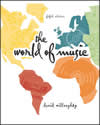|
 |  The World of Music, 5/e David Willoughby
World Music: The Western Hemisphere
Chapter 8:
| Native American music | The native cultures considered music and essential part of daily life. Music was mainly functional, consisting primarily of songs and dances designed to achieve some purpose, such as good health, a successful hunt, victory in war, rain, or contact with the spirit world. Music was usually associated with rituals, although some of the songs and dances were purely for entertainment. The music was transmitted by oral tradition rather than notation. Native American music was not intended to be listened to alone, apart from its function. Many songs were valued for their power and were “owned” by individuals who would protect that power by not performing these songs except under special, often ceremonial circumstances. The works to a song may have told a story, expressed a prayer or a wish, or described an emotion. The most common instruments were drums of all shapes and sizes, rattles, and sometimes tambourines or bells and other percussion instruments. Most songs had a small range, seldom more than an octave, and often encompassed only a few tones.
|  |  |  | | Assimilation and preservation | The pressures and the attractions of the “white man’s” world have led some Native Americans to reject their own culture and enter the mainstream of American life. Considering the extent to which Native Americans have been assimilated into American society, their music has not significantly merged with or influenced European-based music, probably because of its radically different style and function.
|  |  |  | | Vocables | When words carry no meaning as words in a song but are intended only as vocal sounds
|  |  |  | | Ethnic American music | By the 1890s, recordings of folk music were available in Yiddish, Polish, Czech, Spanish, and many other languages. These recordings supplemented memories of the homeland and reinforced the worth of retaining old languages and customs in the new land. The diverse culture of the United States provides an abundance of musical styles from various immigrant and minority groups, homogeneous communities, and other identifiable groups. All hold on to valued parts of their original culture, such as certain songs and dances, sometimes in the original forms, but more often in modified forms reflecting various degrees of assimilation into the host culture.
|  |  |  | | Music of Canada | The first permanent colonies, in the early 1600s, were settled by immigrants from northern France. They were farmers who apparently loved to sing and dance. More than 9000 French Canadian folk songs have been identified. These were songs that could be performed without elaborate planning, rehearsal, or special facilities. They were largely unaccompanied. There were multiple texts for any one melody and multiple melodies for any one text. The voyagers (French Canadians) developed a substantial folk song tradition. The British influence was significant as well. Immigrants from England, Scotland, and Ireland brought their ballads, folk songs, reels, and jigs. It was a common practice in the nineteenth century to compose new folk songs or set “Canadian” words to old tunes. Canada’s popular music has been its folk ballads and songs, followed by parlor songs and contemporary popular music. The classical music of Canada is based on western European art music. It includes organ and choir music for church services, chamber music, and concert music. In recent decades, there has been a great increase in the creation, performance, teaching, and awareness of music consciously reflecting nationalistic aspects of Canadian life. Canadians have also been active in jazz and in composing and performing experimental, avant-garde, and electronic music.
|  |  |  | | Music of South America, Mexico, and the Caribbean | Traditional music from these areas were influenced by indigenous folk culture, popular and folk music styles from Spanish and Portuguese and African practices, instruments commonly used in popular and folk music, churches and missionaries, music schools and conservatories, European models of art music, and beginnings of nationalism in art music.
|  |  |  | | Indigenous folk culture | The folk and popular music of Latin America is derived mostly from the traditions of the mestizo people, natives of mixed South American Indian and Spanish ancestry. Mestizo music exists throughout most of South America. It is the indigenous music of Latin America. This music was often derived from a combination of Spanish tunes and words with native dances. The music of African derivation, based largely on dance, exists in the Caribbean islands. Several South American Indian groups apparently had strong musical traditions. The natives learned the songs of the white people, adapting these songs to their own ways of performing music; natives also learned white people’s ways of performing music, adapting those practices to their own songs.
|  |  |  | | Spanish religious culture | From the early sixteenth century on, the musical life of the South American natives was dominated by the Roman Catholic Church. The missionaries taught the Indians Gregorian chant and Renaissance polyphonic church music. The cathedral was the center of public life in the community. Indians were employed as church musicians but seldom for the more prestigious and better-paying positions of chapelmaster or organist. Cathedral musicians, including Indians and mestizos, became composers and performers of religious art music and of secular art concert music as well. They created songs of praise for religious fiestas and processions, musical plays, opera, chamber music, and salon music for the piano.
|
|
|



 2003 McGraw-Hill Higher Education
2003 McGraw-Hill Higher Education